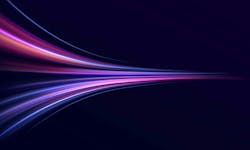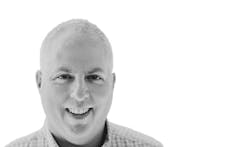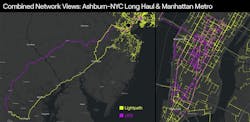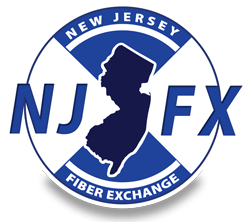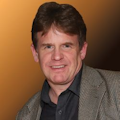Lightpath sets new optical fiber network expansion and customer service course
As Lightpath moves forward with its acquisition of United Fiber and Data (UFD), a growing provider of fiber network infrastructure, the provider enhances its reach to address enterprise and data center customers better.
By purchasing UFD, the service provider, they added a geographically diverse, high fiber count between New York City and Ashburn, VA, while increasing its serviceable market in Manhattan by over 20%.
After meeting regulatory approvals, Lightpath expects the acquisition to close in the third quarter of 2024.
Doug Turtz, Lightpath's Chief Revenue Officer, said acquiring UFD was a natural fit.
“It was a natural bolt-on acquisition,” he said. “It added high volume capacity both dark and lit fiber capabilities, including 300 more miles of backbone fiber that we can leverage and use, which is unique because it's diverse.”
Fiber-rich assets
A big part of the UFD acquisition is the fiber assets. UFD owns and operates a unique and diverse 323-route mile, high-fiber count network between New York City and Ashburn, VA, connecting the country's largest population center with the world's largest data center and cloud ecosystem.
UFD's New York City-Ashburn network offers high fiber counts and will support dark fiber, Ethernet, and wavelengths up to 800 Gbps. This network is geographically diverse from typical long-haul routes along the I-95 corridor. It will enhance Lightpath's network of over 20,000 route miles, connecting over 15,000 service locations, including over 140 data centers and seven cable landing stations.
Lightpath said the combination of networks will allow it to offer geographically diverse, high-capacity services from commercial enterprise buildings, cable landing stations, and data centers along the East Coast directly to the Ashburn ecosystem.
The addition of UFD's assets also further enhances Lightpath's Manhattan metro network coverage. It will serve nearly 1,500 enterprise and data center destinations, a fivefold increase over the past three years.
“Lightpath has over 15,000 service locations today, and with the 20,000 route miles we have, we can better respond to new offices rounding up capacity requirements,” Turtz said.
Lightpath also gained 350 new enterprise customer locations, most of which are new to the company. This makes the company more valuable to existing and new enterprise customers who are scaling their businesses.
UFD customers will gain access to the entire Lightpath network and service portfolio, including Wavelengths, Ethernet, Internet, Private Networks, Dark Fiber, LP FlexNet, Voice, Security Solutions, and other Managed Services. Likewise, existing Lightpath customers will be able to access UFD's dark fiber and lit fiber network services.
“By acquiring UFD, we can extend our complete product set to more locations,” Turtz said. “The additional capacity combined with the uniqueness of UFD’s river crossing fits our East Coast reach model.”
Focus on diversity
Another critical element of the UFD purchase is that it provides diversity and the ability to bypass congested fiber conduit and network routes.
UFD brings a 79-route mile metro network in New York City and New Jersey, including connectivity to over 350 enterprise and data center locations and a high-fiber count crossing of the Hudson River, adding capacity to Lightpath's three existing Hudson River crossings.
“We were also happy to learn when we looked at UFD that it had a unique Hudson River crossing,” Turtz said. “You start to think about how difficult it has become to find pathways between New York City and North Jersey via the legacy Amtrak or Holland tunnels, which have gotten more congested.”
He added that enhancing diversity also enables Lightpath to address disaster recovery better and get access to more data centers.
“So when you think about disaster recovery or reaching data centers, do you necessarily want to go through all the places that are heavily trafficked, or do you want to stay outside them,” Turtz said. “This affords us that unique opportunity to balance those two things, and we have another route to Virginia.”
Enhancing data center reach
The UFD deal also enhances Lightpath’s data center capabilities.
Data centers are also a key priority for Lightpath. Lightpath has presence in over 140 data centers and several submarine cable landing stations today.
Lightpath continues to serve data center operators and other companies trying to reach data centers.
Turtz said that while it is seeing both types of customers, a growing majority of the services it provides are data center providers themselves.
“We see the data center providers at least wanting to link up their centers to offer high-capacity bandwidth so that they are physically, but seemingly virtually right next door for their occupants,” he said. “We know who all the big tier Tier 1 providers in the data center space are and are actively building into those.”
Additionally, Lightpath sees more enterprises looking to align themselves with cloud providers and data centers. “The other thing that we're seeing is more and more hyperscalers and then other people wanting to align themselves with cloud providers with the hyperscalers and cloud providers,” Turtz said. "To my delight, this has occurred in the enterprise space where the most prominent enterprises say we need to be located locally with these folks operating in the cloud space.”
Tailoring customer needs
The other attractive element of the UFD deal is the customer base it brings to Lightpath.
In recent years, UFD has been attracting a sizeable list of high-profile customers for its fiber-based services, including traditional large international carriers like Deutsche Telekom Global Carrier and Eastlink.
By acquiring UFD, Lightpath also enhances its connectivity and relationship with NJFX, a cable landing station (CLS) colocation campus that offers Tier 3, carrier-neutral data center capabilities.
NJFX’s campus hosts over 35 global and U.S. operators, including multinational banks that require always-on connectivity. The NJFX campus is also where the major cloud operators have their global backbones physically connecting transatlantic cables to Europe and South America.
“So, we are seeing international customers that must reach new endpoints," Turtz said. "These customers want to get to the Virginia market or from Virginia to New York to reach data centers in Secaucus, New York or Central New Jersey."
Increasingly, Lightpath is seeing greater demand for higher-speed wavelength and dark fiber services. “Hyperscalers and international carriers are conversing with us about using our 400G multi or dark fiber products while an enterprise might be looking at 10 or 100 Gbps connections,” Turtz said.
Whether it’s a light or dark fiber service, Lightpath's key is to provide a service tailored to its customer's unique needs, and the UFD purchase allows it to further that vision. “If it's a dark fiber customer, they're doing it, and we're helping them manage that infrastructure,” Turtz said. “We then tailor it from a customer perspective, whether SD-WAN, wavelengths, or internet. And if they have something unique that they need run, then our product team and engineering team jump in, and we'll lab test and do certain things with them.”
He added, "UFD’s assets, which bolt into us like a puzzle piece, fit our service vision.”
For related articles, visit the Business Topic Center.
For more information on high-speed transmission systems and suppliers, visit the Lightwave Buyer’s Guide.
To stay abreast of fiber network deployments, subscribe to Lightwave’s Service Providers and Datacom/Data Center newsletters.
About the Author
Sean Buckley
Sean is responsible for establishing and executing the editorial strategy of Lightwave across its website, email newsletters, events, and other information products.
